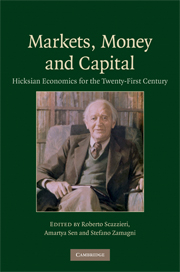Book contents
- Frontmatter
- Contents
- List of figures
- List of tables
- List of contributors
- Preface and acknowledgments
- Between theory and history: on the identity of Hicks's economics
- Part I The Intellectual Heritage of John Hicks
- Part II Markets
- Part III Money
- 11 Historical stylizations and monetary theory
- 12 Hicks: money, prices, and credit management
- 13 Core, mantle, and industry: a monetary perspective of banks' capital standards
- 14 A suggestion for simplifying the theory of asset prices
- Part IV Capital and Dynamics
- References
- Name index
- Subject index
12 - Hicks: money, prices, and credit management
Published online by Cambridge University Press: 29 June 2009
- Frontmatter
- Contents
- List of figures
- List of tables
- List of contributors
- Preface and acknowledgments
- Between theory and history: on the identity of Hicks's economics
- Part I The Intellectual Heritage of John Hicks
- Part II Markets
- Part III Money
- 11 Historical stylizations and monetary theory
- 12 Hicks: money, prices, and credit management
- 13 Core, mantle, and industry: a monetary perspective of banks' capital standards
- 14 A suggestion for simplifying the theory of asset prices
- Part IV Capital and Dynamics
- References
- Name index
- Subject index
Summary
Introduction
Ever since economists have tried to find some kind of correlation between the level of prices and money, going back at least to Richard Cantillon and David Hume, they have come to some expression that relates a general price level to the ‘quantity of money’ (whatever that means) – as it were, an equation of exchange. The ultimate long-run effect of a one-to-one correlation of the level of price and the quantity of money, ceteris paribus, is then the definition of the quantity theory of money. In dynamics outside of equilibrium, however, many economists (such as Irving Fisher, Knut Wicksell, John Maynard Keynes, Friedrich Hayek, and John Hicks), in their pre-war writings, at least came to agree that this theory was not helpful. Wicksell sums it up as follows (see also Fisher, 1907):
The Theory provides a real explanation of its subject matter, and in a manner that is logically incontestable; but only on assumptions that unfortunately have little relation to practice, and in some respects none whatsoever…
The Quantity Theory is theoretically valid so long as the assumption of ceteris paribus is firmly adhered to. But among the ‘things’ that have to be supposed to remain ‘equal’ are some of the flimsiest and more intangible factors in the whole of economics – in particular the velocity of circulation of money, to which in fact all others can be more or less directly referred back. It is consequently impossible to decide a priori whether the Quantity Theory is in actual fact true – in other words, whether prices and the quantity of money move together in practice.
(Wicksell, 1936: 41–2)- Type
- Chapter
- Information
- Markets, Money and CapitalHicksian Economics for the Twenty First Century, pp. 204 - 224Publisher: Cambridge University PressPrint publication year: 2009



